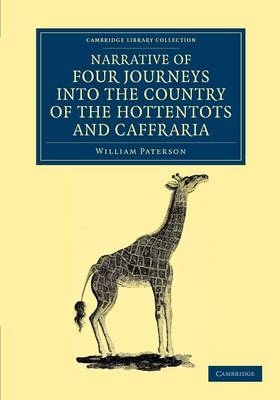
Narrative of Four Journeys into the Country of the Hottentots, and Caffraria
In the Years One Thousand Seven Hundred and Seventy-Seven, Eight, and Nine
Seiten
2012
Cambridge University Press (Verlag)
978-1-108-05052-4 (ISBN)
Cambridge University Press (Verlag)
978-1-108-05052-4 (ISBN)
William Paterson (1755–1810) was an army officer, botanist and friend of Joseph Banks. In 1777 he was dispatched to Cape Colony to collect plant specimens, and his accounts, published in 1789, are the observations of one of the first Europeans to venture into the south-east of modern-day South Africa.
Later known as an administrator in Australia and founder of one of Tasmania's earliest settlements, William Paterson (1755–1810) was an army officer, naturalist and friend of Joseph Banks. Keenly interested in botany from childhood, in 1777 he was dispatched to Cape Colony on an expedition to collect plant specimens, many of which remain in the Natural History Museum. His accounts, published in 1789, are the observations and impressions of one of the first Europeans to venture into the south-east of modern-day South Africa. On his return to England he brought with him the skin and skeleton of a giraffe, which remained on show in the British Museum until the early twentieth century. He writes clearly and engagingly of the people, flora and fauna, assuring the reader that the work is 'a series of facts, noted down upon the spot, without any after additions'.
Later known as an administrator in Australia and founder of one of Tasmania's earliest settlements, William Paterson (1755–1810) was an army officer, naturalist and friend of Joseph Banks. Keenly interested in botany from childhood, in 1777 he was dispatched to Cape Colony on an expedition to collect plant specimens, many of which remain in the Natural History Museum. His accounts, published in 1789, are the observations and impressions of one of the first Europeans to venture into the south-east of modern-day South Africa. On his return to England he brought with him the skin and skeleton of a giraffe, which remained on show in the British Museum until the early twentieth century. He writes clearly and engagingly of the people, flora and fauna, assuring the reader that the work is 'a series of facts, noted down upon the spot, without any after additions'.
Advertisement; 1. First journey; 2 Second journey; 3. Third journey; 4. Fourth journey; Observations on the thermometer, winds and weather; Appendix.
| Erscheint lt. Verlag | 14.6.2012 |
|---|---|
| Reihe/Serie | Cambridge Library Collection - African Studies |
| Zusatzinfo | 1 Maps; 17 Line drawings, unspecified |
| Verlagsort | Cambridge |
| Sprache | englisch |
| Maße | 178 x 254 mm |
| Gewicht | 380 g |
| Themenwelt | Reisen ► Reiseberichte ► Afrika |
| Geschichte ► Allgemeine Geschichte ► Neuzeit (bis 1918) | |
| Geisteswissenschaften ► Geschichte ► Regional- / Ländergeschichte | |
| ISBN-10 | 1-108-05052-2 / 1108050522 |
| ISBN-13 | 978-1-108-05052-4 / 9781108050524 |
| Zustand | Neuware |
| Haben Sie eine Frage zum Produkt? |
Mehr entdecken
aus dem Bereich
aus dem Bereich
Europa 1848/49 und der Kampf für eine neue Welt
Buch | Hardcover (2023)
DVA (Verlag)
48,00 €
Giordano Bruno - ein ketzerisches Leben
Buch | Hardcover (2024)
C.H.Beck (Verlag)
29,90 €


